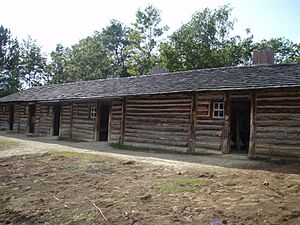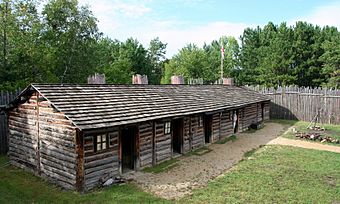Snake River Trading Post facts for kids
 |
|

Museum in 2006
|
|
| Established | 1970 |
|---|---|
| Location | 12551 Voyageur Ln, Pine City, Minnesota, United States |
| Type | Local history |
|
Snake River Fur Post
|
|

The rowhouse reconstructed to its 1804 appearance
|
|
| Built | 1804 |
| NRHP reference No. | 72000679 |
| Added to NRHP | August 7, 1972 |
The Snake River Trading Post is a reconstructed fur trade post located on the Snake River. It is west of Pine City, Minnesota, in the United States. This trading post was first set up in the fall of 1804. It was established by John Sayer, who was a partner in the North West Company. His team of voyageurs helped build it.
The original post was used for several years, but we don't know exactly how long. It was later destroyed by fire. In the 1930s, people found old items at the site. This discovery showed where the post used to be. More digging in the 1960s helped experts learn even more about it. This information allowed them to rebuild the post exactly how it looked. Today, the site is listed on the National Register of Historic Places. It is operated as a state historic site by the Minnesota Historical Society.
Contents
History of the Snake River Trading Post
What Was the North West Company?
The North West Company was a group of British merchants. They formed their company in Montreal in the mid-1780s. This company set up a large trading post at Grand Portage. They also built several other forts. These forts were homes for voyageurs during the winter. Besides the Snake River post, they also built forts in Minnesota at Fond du Lac (now part of Duluth), Big Sandy Lake, and Leech Lake.
Life at a Fur Trading Post
A typical fur trading fort usually had a few main buildings. There was a home for the clerk, who managed the post. There was also a storehouse for goods and a bunkhouse for the voyageurs. About ten to twenty voyageurs would spend the winter at these posts. During the cold months, they would collect animal pelts. These included furs from beaver, otter, muskrat, deer, bear, and marten.
Dakota and Ojibwe men would hunt and skin the animals. The women would then prepare the hides by stretching and drying them. These prepared hides were usually seen as the women's property. So, they would arrange the sales with the trading post clerk. In return, the clerks would give the Native Americans trade goods. These goods included firearms, blankets, and cooking tools. The fur trade had been happening for over 100 years further east. It was helpful for both sides. Native Americans received products from early factories. The furs were sold to Europeans to make felt hats and fur coats.
Rediscovery and Reconstruction
The Snake River Trading Post site was found again in 1931. A local resident from Pine City discovered it. He found items like musket flints in the soil. He kept returning to the site for the next thirty years to explore it. In 1958, he found a book called Five Fur Traders in the North West. This book contained the journal of John Sayer.
The Pine City resident then contacted the Minnesota Historical Society. He explained what he had found. The Minnesota Historical Society did some tests in 1963. These tests helped them understand the site better. From 1965 to 1967, students from Hamline University dug up the site. They found hundreds of old items. The Minnesota Historical Society rebuilt the post in 1968 and 1969. They opened the site to the public in 1970. It was officially listed on the National Register of Historic Places in 1972.
Visiting the Post Today
The reconstructed post shows what it looked like during the winter of 1804–05. The museum is open during the summer months. Guides dressed in costumes help visitors learn about the site. The visitor center has exhibits about the post's history. It also has a large room with a fireplace and a gift shop.
The historic site has had different names in the past. It was known as Connor's Fur Post and the North West Company Fur Post. Its name was changed to the Snake River Fur Post in February 2018.


